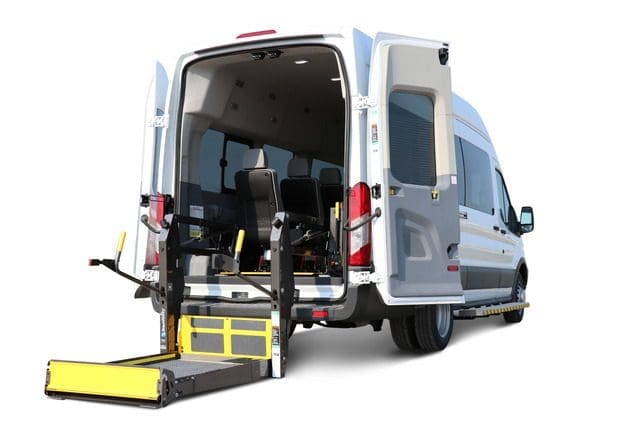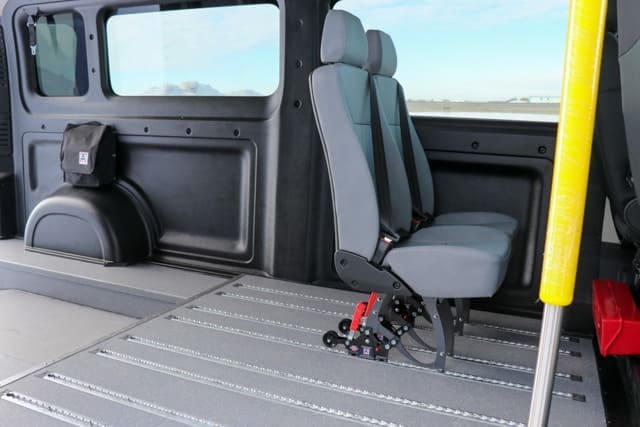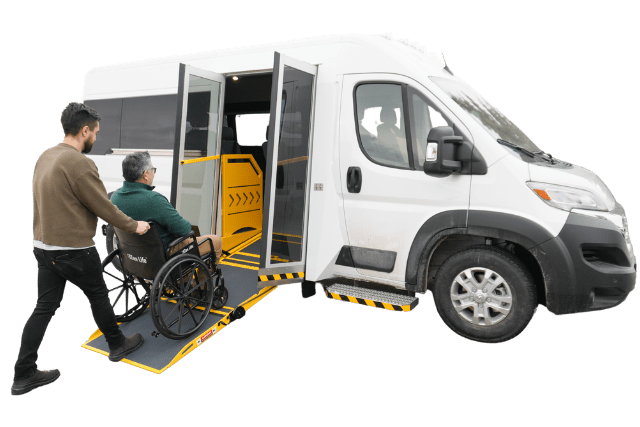Ever had a wheelchair lift stop working at the worst time? You’re trying to help someone into a wheelchair van, and the lift just… doesn’t move. You’re stuck, they’re stuck, and everyone’s stressed. That’s a rough place to be. If this has happened more than once, you might even be asking, “Why isn’t there a simple backup system I can use in moments like this?”
The truth is, there usually is. Most wheelchair lifts for van models come with a manual backup. But many teams don’t know how to use it.
That gap in knowledge leads to:
- Missed appointments: Delays cost more than time.
- Lost trust: Riders need to know you’re reliable.
- Staff stress: No one likes feeling helpless.
- Embarrassment: Imagine being the one stuck at the top of the wheelchair lift?
Knowing how to use the manual system keeps you in control when power systems fail, and that’s a huge bonus.
At MoveMobility, we’ve been building accessible vans in Canada for over 20 years. We’re Ford QVM and Stellantis QPro certified, and we’ve worked with organizations like yours coast to coast. Our mission is to remove barriers to care and mobility. And while we know our stuff, we’ll always keep things honest and helpful.
In this article, you’ll learn how to operate the manual backup system on a wheelchair lift, step-by-step.
Step 1: Manually release the wheelchair lift
If your wheelchair lift suddenly stops working, maybe because of a dead battery or a wiring issue, you can still get it moving using the manual backup. You’ll find a guide right on the pump box, but let’s break it down here so it’s easy to follow, even in a pinch.
First thing: Go to the pump box. That’s usually mounted near the lift inside the rear of the van.
Here’s what to do step by step:
- Grab the manual handle: It’s clipped to the rear of the pump box.
- Find the T-screw: You’ll see a small screw head near the pump.
- Insert the handle into the notches: Twist it into the T-screw.
- Turn counter-clockwise (to the left): Slowly loosen the screw. This will start to release the lift for wheelchair users away from the van.
Don’t loosen it too much, just enough to let the platform start moving outward.
Once the wheelchair lift is fully out and on the ground, stop turning. You’re ready to bring the lift back in.
Next up, let’s look at how to raise the platform using the manual pump system.
Step 2: Manually raise the wheelchair lift back into the van
Once your wheelchair lift platform is safely on the ground, the next step is bringing it back into the van using the manual pump. Think of it like using a small car jack. It’s slow, but it works when you need it.
Here’s how to do it:
- Close the valve: Turn the T-screw back to the right (clockwise) until it’s snug. Just hand-tighten it. Don’t overdo it, or you could damage the pump threads.
- Insert the handle into the pump block: You’ll see a spot for it, just like a bottle jack.
- Start pumping: Use steady, even strokes. The lift will begin to rise back into the van.
Keep an eye on the hand control while you’re doing this. Sometimes, once the lift gets back into a “safe” position, the electric system kicks back in on its own. You might see the orange lights on the control panel light up again. If that happens, stop pumping and switch back to electric mode to save yourself the effort.
Next, we’ll wrap things up by showing you how to finish the job and store the manual tools properly.
Step 3: Reset the wheelchair lift and store the manual backup handle
Once your wheelchair lift is back in position, either manually or because the electric control started working again, you’re almost done. This last step is all about wrapping things up the right way so nothing gets damaged or forgotten.
Here’s what to do:
- Double-check the valve: Make sure the T-screw you turned earlier is snug but not over-tightened. Too much pressure can strip the threads on the pump block.
- Remove the handle: Gently pull it out from the pump block.
- Store the handle: Clip it back into the holding clips on the back of the pump box. That way it’s ready to go next time, if you ever need it.
Quick tip: Some users skip this last step and leave the handle in the pump block. Don’t do that. It can rattle around, get lost, or even cause issues next time you use the lift.
Alright, now that you know how to operate the manual system, let’s talk about when it makes sense to use it and when it’s better to consider getting service.
When should you use the manual backup system, and when should you get wheelchair van lift service?
You now know how to use the manual system on your van wheelchair lift, but when should you actually use it?
Let’s be honest: Manual backup systems are great for short-term fixes. They get you out of a jam when someone needs to board or exit, and the power fails. But they’re not a long-term solution.
Use the manual system when:
- The lift stops responding, but you need to get someone on or off right away
- You notice a minor electrical issue, but everything else looks safe
- You’re in a remote area and waiting for help isn’t an option
Take your wheelchair van for service when:
- The wheelchair lift fails more than once in a short time
- The lift gets stuck halfway and won’t budge electrically
- You see damaged parts, fluid leaks, or hear loud grinding sounds

Using the manual system is like a spare tire. It’s helpful, but you don’t want to rely on it every day. Once you’re back at your home base or facility, have a technician inspect the lift.
How do you prevent having to use the manual system on your wheelchair lift?
Using the manual system on your wheelchair lift is helpful in emergencies, but most people would rather not have to deal with it at all. The good news? A little routine care goes a long way.
Here’s how to cut down on lift issues before they happen:
- Do regular lift checks: Run the lift through its full cycle every week. That helps catch problems early.
- Look for warning signs: Slower-than-usual movement, flickering lights, or odd sounds can mean trouble.
- Train your team: Make sure everyone who uses the van knows how the lift works and how the manual system works, too.
Tired of your old wheelchair van lift not working?
You probably landed on this article because your wheelchair lift failed or you’re worried it might. You’ve felt the pressure of trying to help someone board or exit while the lift refuses to move. That’s a tough spot to be in.
Now that you’ve made it through, here’s a quick look at what you’ve learned:
- How to manually release and raise your wheelchair lift for van use
- When it’s safe to use the manual backup and when to call for help
- Simple steps to prevent problems before they happen
At MoveMobility, we’ve spent over two decades working with frontline teams across Canada. We build wheelchair accessible vans designed for reliability, safety, and simplicity because the people you serve deserve better than unreliable equipment. Every van is backed by our team of certified experts who care deeply about helping you do what you do best. We lead with compassion, experience, and real-world know-how.
Are you tired of dealing with the same old wheelchair lift issues? Talk to a mobility expert today if you think it might be time for something new. We’ll walk you through your options with no pressure.
If you’re not quite ready to talk to someone yet, we’ve got more resources you can check out to keep learning.
Start by checking out our article on the top five issues with wheelchair lifts.
After that, read our guide comparing ramps vs. lifts for wheelchair vans. If you’re having trouble deciding between these two options, this one will be helpful.





